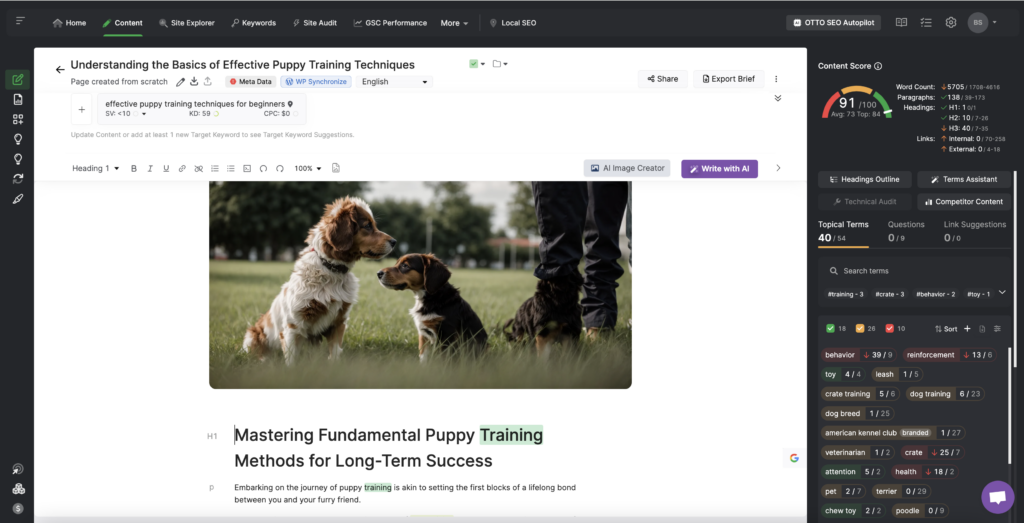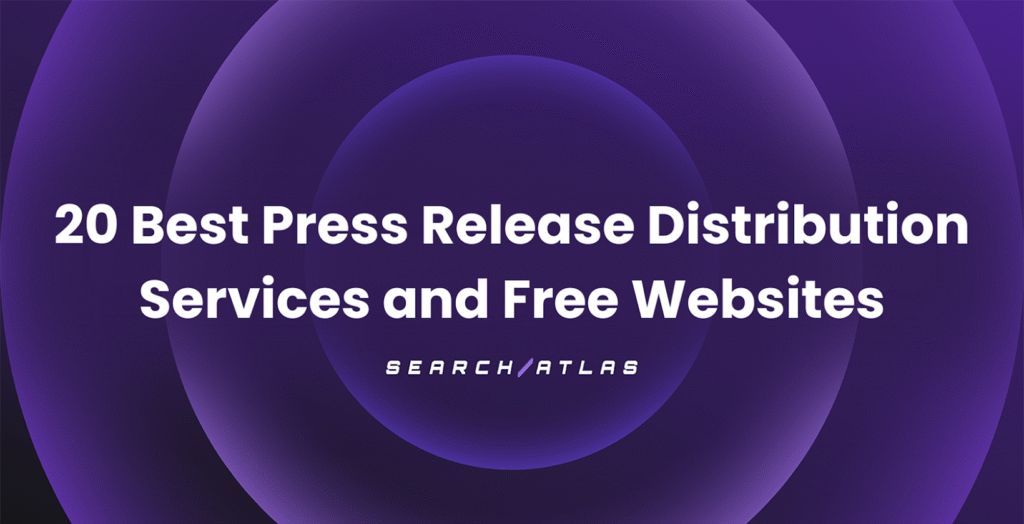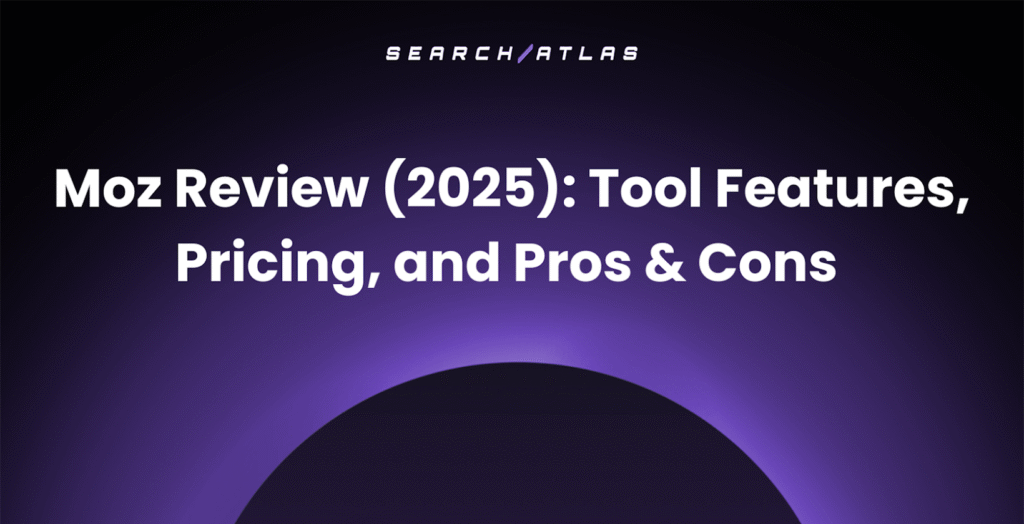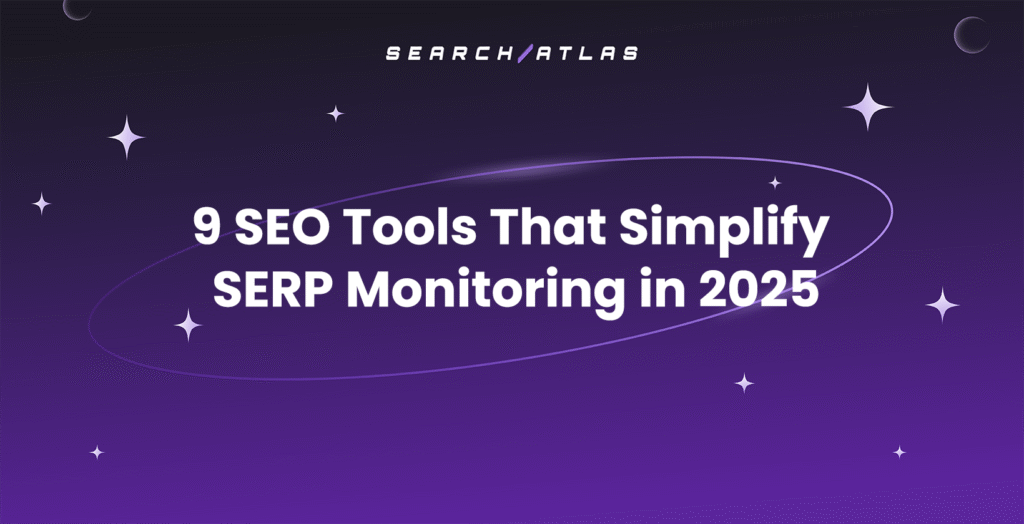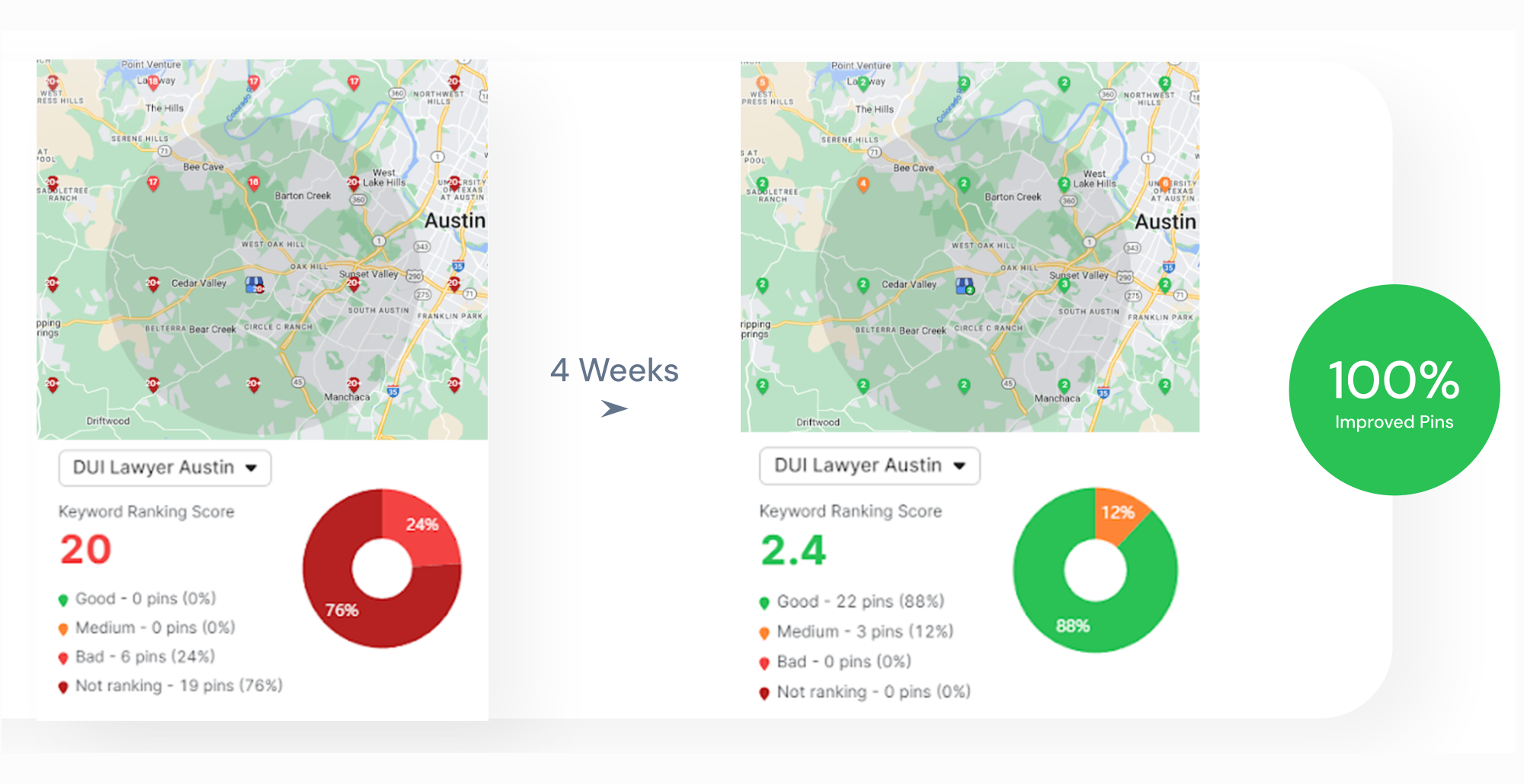It’s a common issue: hours spent on SEO, but with little clarity on what’s truly working. 😐
This is why we need to know exactly how to measure SEO performance. It’s not just about collecting data, it’s about understanding it.
And, critically, it’s about leveraging the right tools. The right SEO tools cut through the noise, providing clear, actionable insights. And, like our Site Explorer tool, they come with maximum user-friendliness.
As a company specializing in collecting and using SEO data, we created a clear, step-by-step breakdown of how to measure, sort, interpret, and leverage the data for success.
SEO Performance vs. SEO Results
Okay, let’s start by making a distinction between the two, because we will be focusing on performance today. Think of it like this:
- SEO Performance is the process: Are you doing the right things? Are your keywords ranking higher? Are you getting more traffic? It’s about how well your SEO strategy is working.
- SEO Results are the outcome: Are you making more money? Getting more leads? Are people finding your brand? It’s about the actual benefits you’re seeing from your SEO.
So, you could be doing great on performance (traffic’s up!), but still not seeing the results you want (no new sales!). That’s why it’s important to track both. Performance tells you how you’re doing, and results tell you what you’re getting.

Tips on Measuring SEO Performance
Okay, it’s time to take control of your data. Use these tips to get a clear view of your site’s SEO performance.
1. Organic Traffic: See How Attractive Your Site is to Users
Organic traffic refers to visitors who find your site through search engines without paid ads—a paid ads strategy can be done with PPC research tools.
It’s one of the most important indicators of SEO success because it reflects how well your content ranks and attracts users. However, not all traffic spikes lead to conversions, quality matters as much as quantity.
Google Search Console is one of the best ways to measure organic traffic accurately. However, its interface can be overwhelming, even for more experienced marketers. Search Atlas simplifies the process by integrating GSC data into a user-friendly dashboard with key SEO insights.
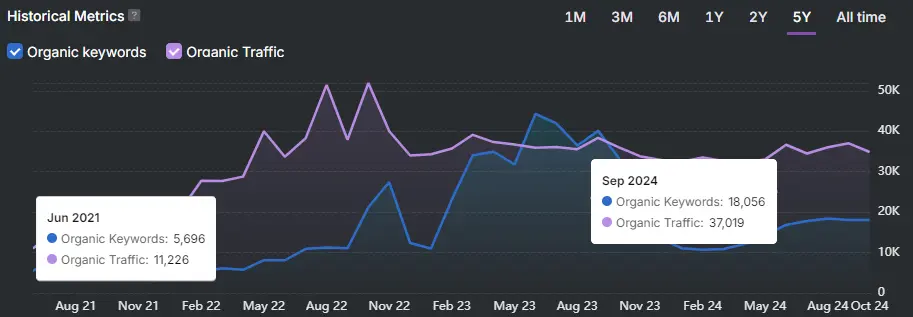
If you’re managing a business website, the next thing you should measure is how much of your traffic is brand-related.
Branded traffic comes from searches that include your company name (e.g., “Nike running shoes”), while non-branded traffic comes from generic searches (e.g., “best running shoes”).
Measuring both helps you see if people find your site because they already know your brand or through SEO efforts. If Nike saw most of its traffic coming from branded searches, it would mean strong brand recognition, but to grow, it would need more non-branded traffic from people searching for general running shoe terms.
Measuring this in GSC is a bit more complicated, but Search Atlas makes it a part of its main insight dashboard. In other words, there’s no need for a ton of manual checks.
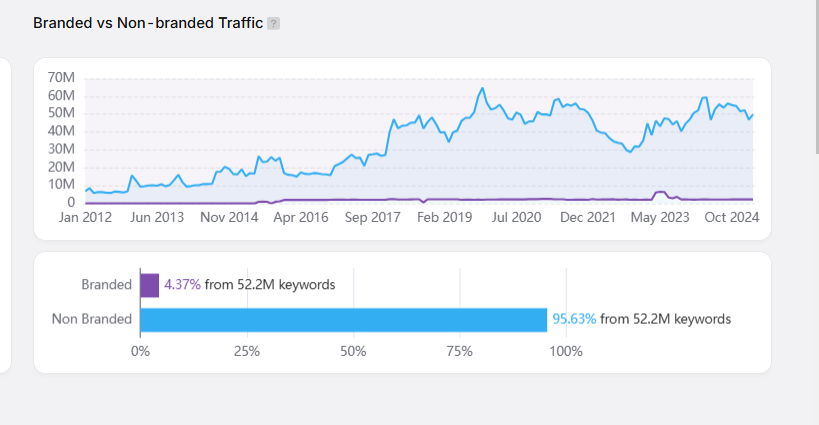
The Site Explorer simplifies other traffic metrics by offering a wide range of filters, including additional insights such as:
- Traffic by Device
- Traffic by Country
- Traffic by Keyword Position
- Traffic By Top Pages
Why Organic Traffic Fluctuates
Okay, so you’ve got your data, and you’ve noticed fluctuations that are making you uneasy (or thrilled). Here are some common reasons:
- Google Indexing New Pages: If traffic suddenly increases, Google may have indexed fresh content or reassessed existing pages.
- Algorithm Updates: Drops in traffic can indicate a ranking shift due to changes in Google’s algorithm.
- Click-Through Rate (CTR) Issues: If impressions grow but traffic remains the same, weak meta descriptions or titles may be the issue. Optimizing these can improve CTR.
- Keyword Ranking Plateaus: If keyword rankings increase but traffic doesn’t, pages may not rank high enough (typically outside the top 3 positions).
2. Keyword Rankings: Discover What Searchers are Finding You For
Measuring SEO performance goes beyond just looking at overall organic traffic. While GSC shows you traffic trends, it doesn’t reveal the relevance of that traffic. That’s where keyword rankings come in.
Keyword positions (your website’s ranking in search results for specific keywords) tell you which searches are bringing people to your site.
To understand how these trends change over time, you need historical keyword rank tracking or keyword research tools that shows keyword trends. If rankings improve but traffic doesn’t, it may indicate issues with CTR or search intent alignment.
If rankings decline, you can identify when and why, such as algorithm updates or competitor gains. Search Atlas shows you these trends clearly.

Also, Site Explorer’s “Page Positions” feature gives you another snapshot of your ranking changes. See if your pages are New, Improved, Declined, or Lost. You can also easily sort by search volume, user intent, and other key metrics to quickly understand your website’s performance.
But there’s another thing we have to emphasize. Because of changes in how Google handles JavaScript, many popular tools that rely on scraping are becoming less accurate and more expensive.
Our tool does not have this problem, Search Atlas offers a solution by integrating directly with GSC, providing more accurate and cost-effective rank tracking, giving you a complete picture of your SEO performance.
What Keyword Ranking Changes Are Telling You
We’ll give you a checklist of symptoms and what they can mean:
- Ranking Increases: Your SEO efforts are paying off, leading to better visibility and potentially more traffic.
- Ranking Drops: Competitors may have overtaken you, Google’s algorithm may have changed, or your content may need updates.
- Fluctuating Rankings: Google is testing your page’s relevance for different queries, or rankings are unstable due to algorithm adjustments.
- New Keyword Rankings: Your content is now appearing for additional search queries, expanding your reach.
- Lost Keyword Rankings: Pages may have been deindexed, search intent may have shifted, or competitors have gained an edge.
- Ranking Stagnation: Your content ranks but isn’t improving, often due to strong competition, low authority, or lack of optimization.
3. Impressions: Measure Your Website’s Visibility in Search Results
Impressions measure how many times your website appears in Google search results. Think of them as a sneak peek of your potential traffic.
If your impressions are growing, especially after improving your keyword rankings, it’s a strong indicator that clicks and traffic will likely increase soon.
Tracking impressions helps you gauge the early success of your SEO efforts. You can view this data in GSC, or directly within Search Atlas’s Performance tab, including a 90-day trend view.
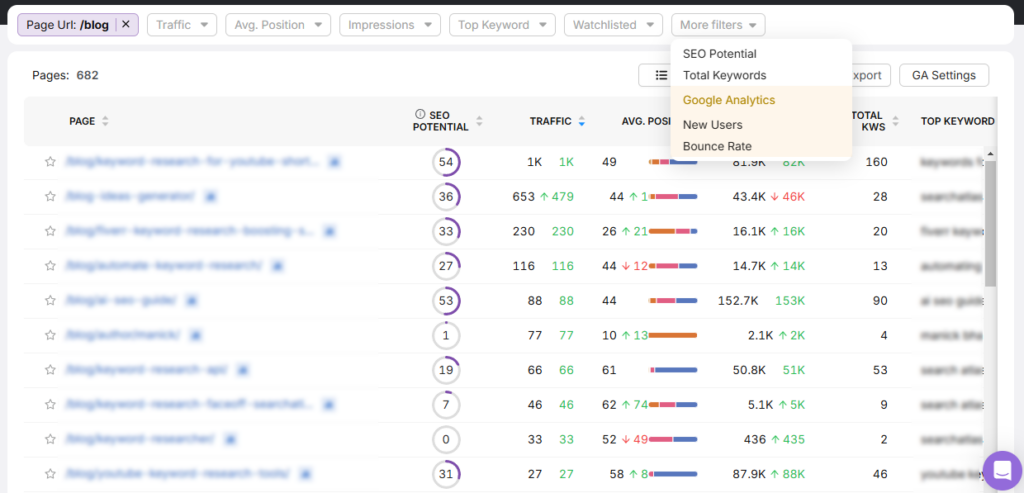
What Impressions Are Telling You
Changes in impressions in SEO performance can indicate:
- Increased Impressions: Google is showing your pages to more users, often due to better rankings, new keyword visibility, or expanded index coverage.
- Decreased Impressions: Rankings may have dropped, search demand for your keywords may have declined, or Google may have deindexed pages.
- Stable Impressions, Low Clicks: Your pages are appearing in search but not attracting clicks, often due to weak meta titles, descriptions, or low ranking positions.
- Spikes in Impressions: A sign that Google is testing your content for different queries or a seasonal trend is driving more searches.
- Sudden Drops in Impressions: Possible causes include algorithm updates, site issues, or losing keyword rankings to competitors, which you can check with competitor analysis tools.
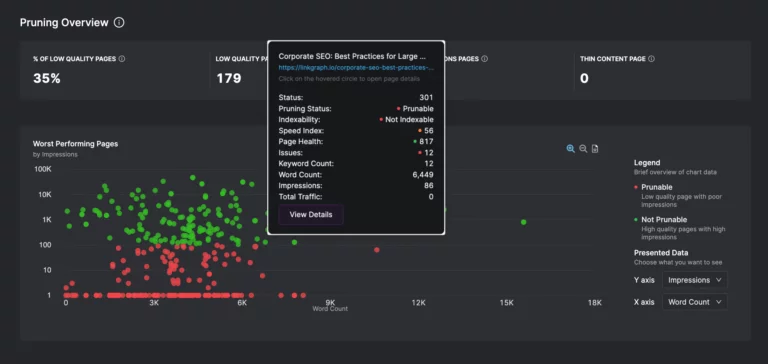
Speaking of impressions, Search Atlas also gives you a bonus feature called Page Pruning Tool. With this you can use impressions as a filter to find pages that are not performing well enough.
And of course, get rid of them or fix them.
4. Conversion Rate: Measure Your Site’s Business Power
Okay, so you’re getting traffic, but are those visitors actually doing anything? That’s where conversion rate comes in. It tells you what percentage of your website visitors are becoming customers or leads. Basically, are you attracting the right kind of visitors – people who are actually interested in what you offer?
Think of it this way: if your traffic goes up, but your conversions stay flat, something’s off. Either you’re attracting the wrong audience, or your website isn’t convincing them to take action (maybe your landing pages need some work!).
And here’s a big thing to remember: more traffic doesn’t automatically mean more conversions. It’s about quality, not just quantity. You want visitors who are likely to buy, sign up, or whatever your goal is.
And if you want high conversion rates, you will also need to optimize your landing pages.

In the GSC Performance tab, you’ll be able to see how your site and your pages are doing in this arena. And if you need to report it to your clients, you can also use the Report Builder tool.
It will show you not only your website impressions, but also your GBP impressions, conversions, and clicks, as well as conversions by source (social media, paid, organic, and more).
What Conversion Rates Are Telling You
So here’s what you can learn from this metric:
- Increase in Conversion Rate: Your SEO efforts are targeting the right audience and driving relevant traffic.
- Decrease in Conversion Rate: Potential mismatch between your audience and content, or landing page issues that need attention.
- Fluctuating Conversion Rates: Variations may indicate seasonal changes, algorithm shifts, or inconsistent user experience.
- No Change in Conversion Rate: Traffic quality or user experience may not be aligned with SEO strategy or audience expectations.
5. Bounce Rate: See How Many People Leave
Bounce rate tracks how many visitors leave your site after viewing only one page.
Now, a high bounce rate can be a red flag. It might mean your content isn’t relevant to what people were searching for, or maybe your website is difficult to use.
Google and other search engines pay attention to this because they want to show users results that are helpful and engaging. A lower bounce rate often signals a better user experience, which is a big plus for SEO.
But a high bounce rate doesn’t always mean your SEO is terrible. Sometimes, it’s perfectly fine! For example, if someone finds exactly what they need on that first page (like a phone number or address), they might leave quickly, and that’s okay.
Or, if you have a single-page website, your bounce rate will naturally be higher. The key is to understand the context behind the number.
It is also a misconception to think bounce rate is just about your content. While great content is important, it’s not the only factor. Think about your website’s speed, navigation, and the user experience as a whole.
What Your Bounce Rate is Telling You
You’ll be able to find your bounce rate in your GSC Performance Tab in Search Atlas, too. This is what it can tell you:
- Increase in Bounce Rate: Potential issues with user experience, irrelevant content, or slow page load times.
- Decrease in Bounce Rate: Users are engaging more with your content, possibly due to improved relevance or UX.
- Fluctuating Bounce Rate: May signal inconsistent content quality or shifts in user behavior, often due to seasonal changes or algorithm updates.
- No Change in Bounce Rate: Indicates stable user engagement but may also suggest that current SEO strategies aren’t moving the needle.
6. Backlinks: Gauge Your Website’s Reputation and Authority
Okay, let’s talk backlinks—they’re a HUGE deal for SEO. Think of them as votes of confidence from other websites. When other sites link to yours, it tells Google your content is valuable and trustworthy.
Basically, the more high-quality backlinks you have, the better your chances of ranking higher in search results. But building a good backlink profile is not just about the number. Quality matters way more than quantity.
One link from a respected, relevant website is worth far more than dozens of links from low-quality or spammy sites. In fact, those bad links can actually hurt your SEO.
Finally, don’t think of backlinking as a one-and-done task. It’s an ongoing effort. You need to keep working to earn (and maintain) high-quality backlinks to keep your SEO strong. It is not a ‘set it and forget it’ kind of thing.

In Search Atlas, you can do one of the most comprehensive backlink analyses on the market. The Backlink Analyzer lets you look at any website and see its backlinks, compare these profiles among competitors, and find gaps you could use to your advantage.
Don’t like link building? You can also use the OTTO SEO AI Assistant to automate a lot of its aspects. And many, many other SEO tasks.
What Your Backlink Profile is Telling You
Your backlink profile can show you several things:
- Increase in Backlinks: Your content is gaining credibility and recognition from authoritative sources, which can positively impact rankings.
- Decrease in Backlinks: You may have lost important backlinks, possibly due to page removals, broken links, or competitors outperforming you.
- Fluctuating Backlinks: Changes in backlinks suggest content shifts, quality changes, or inconsistent link-building efforts, often impacted by algorithm updates or competition.
- No Significant Changes in Backlinks: Indicates your link-building efforts are stable, but to remain competitive, you may need to actively pursue new high-quality backlinks.
7. Domain Power: Understand the True Strength of Your Site
Site authority metrics aim to predict how well a site will perform in search results, based on various factors. Think of them as a shorthand way to gauge a website’s “reputation” in the eyes of search engines.
However, traditional SEO authority metrics often rely on backlinks. But here’s the problem: backlinks can be manipulated. Some websites use shady tactics like link farms or spam networks (think tons of low-quality links from irrelevant sites) to artificially inflate their authority scores.
That’s why Search Atlas created a more accurate metric: Domain Power (DP). DP focuses on real performance data—organic traffic and ranking keywords—pulled directly from Google Search Console (GSC).
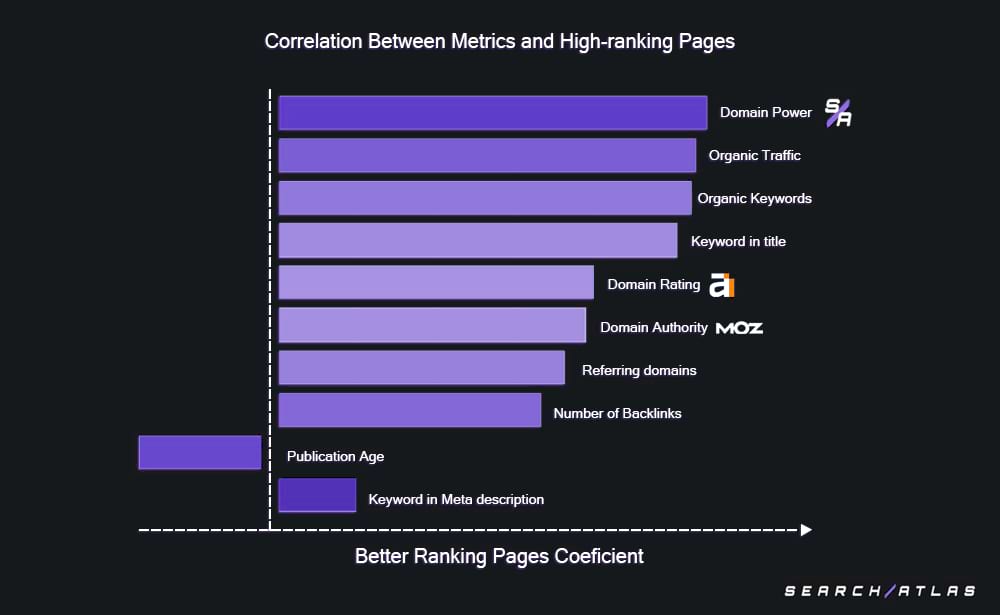
This gives you a much more accurate picture of a site’s true authority, because it’s based on how the site actually performs in search results, not just how many backlinks it has.
Still, we do provide other metrics along with our own, along with a (bulk) DA checker, so you can get any info you need for clients.
What Domain Power Is Showing You
Here’s cheatsheet on Domain Power:
- Sudden Drop: Could indicate a Google penalty, a major algorithm update impacting your site, or a loss of significant organic traffic/keyword rankings.
- Steady Decline: Suggests your site is losing ground to competitors, possibly due to outdated content, technical issues, or a weaker overall SEO strategy.
- Sudden Increase: Might be the result of a successful content campaign, gaining high-quality traffic, or a positive algorithm update favoring your site.
- Steady Growth: This is the ideal scenario! It indicates consistent improvement in your organic traffic and keyword rankings, reflecting a strong SEO strategy.
- No Change: If your DP is consistently flat, there is likely a missed opportunity, and your site is not growing.
8. Technical SEO: Ensure Your Site’s Search-Engine Compatibility
Technical SEO might not be as glamorous as content creation or link building, but it’s the foundation of a high-performing website. Think of it as the engine of your car, if it’s not running smoothly, it doesn’t matter how beautiful the exterior is.
There are a lot of technical SEO tools and they should show metrics that measure the “health” of your website’s infrastructure, ensuring it’s easily crawlable, indexable, and user-friendly for both search engines and visitors.
These metrics include things like site speed, mobile-friendliness, crawl errors, broken links, HTTPS status, and structured data implementation.
Whether you enjoy this aspect of SEO or not, the tools Search Atlas has to offer will give you something to consider. Because it’s all about automation.
First, you have the Site Audit tool for more traditional technical SEO fixes, but with plenty of automated fixes, 24/7 tracking, and more.
And then there’s our AI assistant OTTO SEO, which automates the whole process and lets you handle fixes with one click.
You don’t even have to go to WordPress, it’s all integrated in the dashboard.
What Your Technical SEO Changes are Telling You
Let’s decode those signals:
- Sudden Increase in Crawl Errors: Indicates that search engines are having trouble accessing your website’s pages, potentially harming your rankings and visibility.
- Drop in Site Speed: Signals that your website is loading slowly, frustrating users and potentially leading to higher bounce rates and lower rankings.
- Mobile-Friendliness Issues: Means your website isn’t optimized for mobile devices, which can negatively impact your rankings in mobile search results (and user experience!).
- Increase in Broken Links: Suggests a poor user experience and can signal to search engines that your site is not well-maintained.
- Security Warnings (HTTPS Issues): Indicates that your site is not secure, which can damage user trust and potentially lead to ranking penalties.
- Structured Data Errors: Shows that search engines might not fully understand your content, limiting your chances of appearing in rich results.

SEO Performance Made Easy: Try Search Atlas
In the past, measuring SEO performance was a daunting task, often involving multiple tools and manual analysis.
Today, SEO relies on AI to analyze vast datasets, identify hidden opportunities, and make data-backed decisions. AI can automate reporting, detect anomalies, and even provide predictive insights.
Search Atlas is built for this new reality. It’s not just another SEO tool. It’s a comprehensive platform designed to simplify and enhance your performance tracking.
Why not try it for yourself? Sign up for a 7-day FREE trial and test the most innovative tools in the industry.


